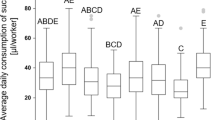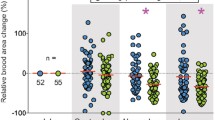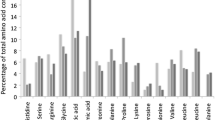


Similar content being viewed by others
References
Allen, M.D., Jeffree, E.P. (1956) The infuence of stored pollen and of colony size on the brood rearing of honeybees. Ann. Appl. Biol. 44, 649–656
Amdam, G.V., Omholt, S.W. (2002) The regulatory anatomy of honeybee lifespan. J. Theor. Biol. 216, 209–228
Amdam, G.V., Aase, A.L.T.O., Seehuus, S.C., Fondrk, M.K., Norberg, K., Hartfelder, K. (2005) Social reversal of immunosenescence in honey bee workers. Exp. Gerontol. 40, 939–947
Amdam, G.V., Rueppell, O., Fondrk, M.K., Page, R.E., Nelson, C.M. (2009) The nurse's load: early-life exposure to brood-rearing affects behavior and lifespan in honey bees (Apis mellifera). Exp. Gerontol. 44, 467–471
Bitondi, M.M.G., Simoes, Z.L.P. (1996) The relationship between level of pollen in the diet, vitellogenin and juvenile hormone titres in Africanized Apis mellifera workers. J. Apic. Res. 35, 27–36
Blaschon, B., Guttenberger, H., Hrassnigg, N., Crailsheim, K. (1999) Impact of bad weather on the development of the broodnest and pollen stores in a honeybee colony (Hymenoptera: Apidae). Entomol. Gen. 24, 49–60
Crailsheim, K. (1990a) Protein-synthesis in the honeybee (Apis mellifera L) and trophallactic distribution of jelly among imagos in laboratory experiments. Zool. Jahrb. Allg. Zool. 94, 303–312
Crailsheim, K. (1990b) The protein balance of the honey bee worker. Apidologie 21, 417–429
Crailsheim, K., Schneider, L.H.W., Hrassnigg, N., Buhlmann, G., Brosch, U., Gmeinbauer, R., Schoffmann, B. (1992) Pollen consumption and utilization in worker honeybees (Apis mellifera carnica)—dependence on individual age and function. J. Insect. Physiol. 38, 409–419
Davila, J.C., Cezar, G.G., Thiede, M., Strom, S., Miki, T., Trosko, J. (2004) Use and application of stem cells in toxicology. Toxicol. Sci. 79, 214–223
DeGrandi-Hoffman, G., Wardell, G., Ahumada-Segura, F., Rinderer, T., Danka, R., Pettis, J. (2008) Comparisons of pollen substitute diets for honey bees: consumption rates by colonies and effects on brood and adult populations. J. Apic. Res. 47, 265–270
Eischen, F.A., Rothenbuhler, W.C., Kulincevic, J.M. (1982) Length of life and dry weight of worker honeybees reared in colonies with different worker–larva ratios. J. Apic. Res. 21, 19–25
Ellis, J.D., Munn, P.A. (2005) The worldwide health status of honey bees. Bee World 86, 88–101
Fewell, J.H., Winston, M.L. (1992) Colony state and regulation of pollen foraging in the honey-bee, Apis mellifera L. Behav. Ecol. Sociobiol. 30, 387–393
Fewell, J.H., Winston, M.L. (1996) Regulation of nectar collection in relation to honey storage levels by honey bees, Apis mellifera. Behav. Ecol. 7, 286–291
Haydak, M.H. (1937) The influence of a pure carbohydrate diet on newly emerged honey bees. Ann. Entomol. Soc. Am. 30, 258–262
Haydak, M.H. (1970) Honey bee nutrition. Ann. Rev. Entomol. 15, 143–156
Johnson, R.M., Evans, J.D., Robinson, G.E., Berenbaum, M.R. (2009a) Changes in transcript abundance relating to colony collapse disorder in honey bees (Apis mellifera). Proc. Nat. Acad. Sci. USA 106, 14790–14795
Johnson, R.M., Pollock, H.S., Berenbaum, M.R. (2009b) Synergistic interactions between in-hive miticides in Apis mellifera. J. Econ. Entomol. 102, 474–479
Mattila, H.R., Otis, G.W. (2006a) Effects of pollen availability and Nosema infection during the spring on division of labor and survival of worker honey bees (Hymenoptera: Apidae). Environ. Entomol. 35, 708–717
Mattila, H.R., Otis, G.W. (2006b) The effects of pollen availability during larval development on the behaviour and physiology of spring-reared honey bee workers. Apidologie 37, 533–546
Maurizio, A. (1950) The influence of pollen feeding and brood rearing on the length of life and physiological condition of the honeybee. Bee World 31, 9–12
Mayack, C., Naug, D. (2009) Energetic stress in the honeybee Apis mellifera from Nosema ceranae infection. J. Invert. Pathol. 100, 185–188
Morse, R.A., Calderone, N.W. (2000) The value of honey bees as pollinators of US crops in 2000. Bee Culture 128, 1–15
Naug, D., Gibbs, A. (2009) Behavioral changes mediated by hunger in honeybees infected with Nosema ceranae. Apidologie 40, 595–599
Nelson, C.M., Ihle, K.E., Fondrk, M.K., Page, R.E. Jr., Amdam, G.V. (2007) The gene vitellogenin has multiple coordinating effects on social organization. PLoS. Biol. 5, e62
Ohlstein, B., Spradling, A. (2006) The adult Drosophila posterior midgut is maintained by pluripotent stem cells. Nature 439, 470–474
Page, R.E., Erber, J. (2002) Levels of behavioral organization and the evolution of division of labor. Naturwissenschaften 89, 91–106
Rando, T.A. (2006) Stem cells, ageing and the quest for immortality. Nature 441, 1080–1086
Rueppell, O., Fondrk, M.K., Page, R.E. Jr. (2005) Biodemographic analysis of male honey bee mortality. Aging Cell 4, 13–19
Rueppell, O., Bachelier, C., Fondrk, M.K., Page, R.E. Jr. (2007) Regulation of life history determines lifespan of worker honey bees (Apis mellifera L.). Exp. Gerontol. 42, 1020–1032
Rueppell, O., Linford, R., Gardner, P., Coleman, J., Fine, K. (2008) Aging and demographic plasticity in response to experimental age structures in honeybees (Apis mellifera L). Behav. Ecol. Sociobiol. 62, 1621–1631
Rueppell, O., Kaftanouglu, O., Page, R.E. (2009) Honey bee (Apis mellifera) workers live longer in small than in large colonies. Exp. Gerontol. 44, 447–452
Sagili, R.R., Pankiw, T. (2007) Effects of protein-constrained brood food on honey bee (Apis mellifera L.) pollen foraging and colony growth. Behav. Ecol. Sociobiol. 61, 1471–1478
Sagili, R.R., Pankiw, T., Zhu-Salzman, K. (2005) Effects of soybean trypsin inhibitor on hypopharyngeal gland protein content, total midgut protease activity and survival of the honey bee (Apis mellifera L.). J. Insect. Physiol. 51, 953–957
Schippers, M.P., Dukas, R., Smith, R.W., Wang, J., Smolen, K., McClelland, G.B. (2006) Lifetime performance in foraging honeybees: behaviour and physiology. J. Exp. Biol. 209, 3828–3836
Schmickl, T., Crailsheim, K. (2001) Cannibalism and early capping: strategy of honeybee colonies in times of experimental pollen shortages. J. Comp. Physiol. A. 187, 541–547
Schulz, D.J., Huang, Z.Y., Robinson, G.E. (1998) Effects of colony food shortage on behavioral development in honey bees. Behav. Ecol. Sociobiol. 42, 295–303
vanEngelsdorp, D., Hayes, J. Jr., Underwood, R.M., Pettis, J. (2008) A survey of honey bee colony losses in the US Fall 2007 to Spring 2008. PLoS. ONE 3, e4071
vanEngelsdorp, D., Evans, J.D., Saegerman, C., Mullin, C., Haubruge, E., Nguyen, B.K., Frazier, M., Frazier, J., Cox-Foster, D., Chen, Y., Underwood, R., Tarpy, D.R., Pettis, J.S. (2009) Colony collapse disorder: a descriptive study. PLoS. ONE 4, e6481
Vinson, S.B. (1985) Economic impact and control of social insects. Praeger Publishers, New York
Waddington, K.D., Nelson, M., Page, R.E. Jr. (1998) Effects of pollen quality and genotype on the dance of foraging honey bees. Anim. Behav. 56, 35–39
Ward, K.N., Coleman, J., Clittin, K., Fahrbach, S.E., Rueppell, O. (2008) Age, caste, and behavior determine the replicative activity of intestinal stem cells in honeybees (Apis mellifera L.). Exp. Gerontol. 43, 430–437
Winston, M.L. (1987) The biology of the honey bee. Harvard University Press, Cambridge, Massachusetts
Zundel, M.A., Basturea, G.N., Deutscher, M.P. (2009) Initiation of ribosome degradation during starvation in Escherichia coli. Rna 15, 977–983
Acknowledgements
We thank Kaitlin Clinnin for practical support at the early stages of this experiment. We would also like to acknowledge the financial support of the North American Pollinator Protection Campaign and the Agriculture and Food Research Initiative of the USDA National Institute of Food and Agriculture, grant number #2010-65104-20533.
La manipulation des sources de nourriture chez les abeilles provoque des réponses physiologiques au niveau de l’individu et de la colonie.
cellule souche intestinale / pollen/ nutrition / plasticité démographique / mortalité
Zusammenfassung – Physiologische Reaktionen auf Manipulationen des Nahrungsangebots von Individuen und Völkern. Die aktuellen Gesundheitsprobleme der Honigbienen sind vermutlich auf mehrere Faktoren zurückzuführen und daher werden vielfältige Ansätze verfolgt. In diesem Zusammenhang wurden Bienen in dieser Studie am Polleneintrag in den Stock gehindert und stattdessen entweder mit minderwertigen Pollen oder mit frischem Futtersaft (Gelee Royale) gefüttert. Nach einer Eingewöhnungsphase, wurden die zu untersuchenden, jungen Bienen in die Stöcke gegeben und später auf Proteingehalt und Replikation der Stammzellen im Darm untersucht. Zudem wurden die Koloniegrössen, Brutmengen, und die Masse des abgefangenen Pollens der Kolonien aufgezeichnet. Die experimentelle Manipulation der Ernährung im Stock wirkte sich auf individueller und Stock-Ebene aus. Die individuelle Mortalität von Arbeiterinnen und deren interne Proteintiter wurden allerdings kaum beeinträchtigt, aber die Futtersaftdiät führte im Ammenstadium zu einer signifikanten Reduzierung der Zellteilungsraten von Stammzellen in der Darmwand. Die Ernährungsqualität scheint die Darmwand zu beeinflussen. Am Ausgeprägtesten waren jedoch die Unterschiede bei der Brutmenge zwischen den drei Völkern. Dies könnte darauf hinweisen, dass die demografische Plastizität eines Bienenvolkes stärker ist als die individuelle physiologische Plastizität.
Intestinale Stammzellen / Pollen / Ernährung / Demographische Plastizität / Mortalität
Author information
Authors and Affiliations
Corresponding author
Additional information
Manuscript editor: Peter Rosenkranz
Rights and permissions
About this article
Cite this article
Willard, L.E., Hayes, A.M., Wallrichs, M.A. et al. Food manipulation in honeybees induces physiological responses at the individual and colony level. Apidologie 42, 508–518 (2011). https://doi.org/10.1007/s13592-011-0006-z
Received:
Revised:
Accepted:
Published:
Issue Date:
DOI: https://doi.org/10.1007/s13592-011-0006-z




